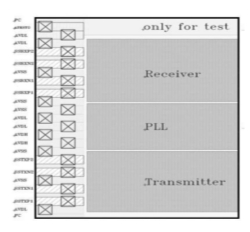The USB3.1Type-C PHY is a high-speed, SERDES IP with high performance that was created for semiconductors that allow high-bandwidth, low-power data transfers. A specific design for USB 3.1 type-C applications is the USB 3.1Type-C PHY IP. A separate PCS can be provided in addition to the USB 3.1 Type C PHY IP to fulfil the functions of various applications, including elastic buffer, scramble/de-scramble, data encoding/decoding, PRBS generation/checking, registers control, and testing. Depending on the needs of the customer, PCS is offered as a hard macro or a soft macro. The PCS standard will also be made available on its own. PHY functionality is verified by the NC-Verilog simulation tool using a test bench created in Verilog HDL..

Deliverables
Physical Layout Representation with Layer Information in GDSII
Layout Exchange Format Views for Placement and Routing
Liberty Format Repository for Timing and Power Characteristics
Functional Simulation Model in Verilog HDL
SDF Timing Constraints Applied to Circuit Connectivity Data
Insights and Recommendations for Effective Layout Implementation
Verification Reports Confirming Layout Schematic and Rule Adherence